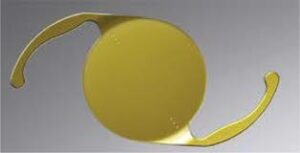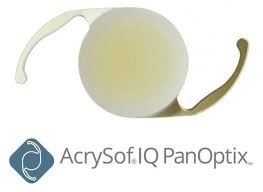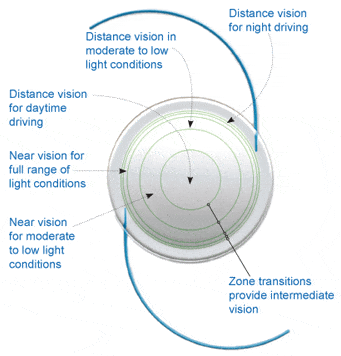Premium Intraocular Lenses
Toric Lens

Toric intraocular lenses (IOLs) are specifically designed for patients with astigmatism. Astigmatism means that the front of the eye (cornea) is shaped more like a football than a baseball. In the past, patients with astigmatism would need eyeglasses or contact lenses, even after cataract surgery. Toric IOLs, such as Acrysof Toric®, corrects cataracts and astigmatism with just one lens, providing a convenient and affordable solution to the patient’s vision needs. This type of lens does not provide distance and near vision at the same time. Reading glasses are usually needed after surgery with this implant.
PanOptix Trifocal Lens

The AcrySof® IQ PanOptix® Trifocal IOL is a type of multifocal IOL used to focus images clearly onto the back of your eye (retina) to allow clear vision after the cataract removal. In addition, the center of the AcrySof® IQ PanOptix® Trifocal IOL allows for better near (reading) vision and intermediate (computer work) vision versus what a monofocal lens would provide. The PanOptix® lens enhances quality as well as range, so your vision will be as sharp and vivid as it is complete.
There is a small chance that you still may need glasses for distance, intermediate, and/or near vision. You will get the full benefit of the AcrySof® IQ PanOptix® Trifocal IOL when it is placed in both eyes. The PanOptix® intraocular implant is also available with astigmatism correcting technology.
As with any multifocal intraocular implant, there is a risk of visual disturbances such as glare, rings around lights, starbursts (rays around light sources), and reduced contrast sensitivity (decrease in ability to distinguish objects from their background, especially in dim lighting). These side effects may make it more difficult to see while driving at night or complete tasks in low lighting conditions, such as at night or in fog or in a dimly lit room, after surgery as compared to before surgery.
For more information please visit panoptix.myalcon.com
Multifocal Intraocular Lens

In the past, intraocular lenses were monofocal, meaning they were only able to correct distance vision, often leaving patients with the need for reading glasses. The PanOptix®, Restor® and Technis® multifocal intraocular lenses offer patients freedom from glasses after cataract surgery by improving vision at all distances, from near to far. Most patients do not need glasses after using this type of implant but there is a chance that you still may need glasses for distance, intermediate, and/or near vision. You will get the full benefit of a multifocal implant when it is placed in both eyes. Multifocal implants are also available with astigmatism correcting technology.
Due to the design of multifocal IOLs, there are some side effects that can be associated with multifocal intraocular lenses. These may be worse than with a monofocal IOL, including visual disturbances such as glare, rings around lights, starbursts (rays around light sources), and reduced contrast sensitivity (decrease in ability to distinguish objects from their background, especially in dim lighting). These side effects may make it more difficult to see while driving at night or completing tasks in low lighting conditions, such as at night or in fog or in a dimly lit room, after surgery as compared to before surgery.
For more information please visit panoptix.myalcon.com, acrysofrestor.com or technismultifocal.com
Monovision
Monovision can help eliminate the need for glasses after cataract surgery by correcting the dominant eye for distance and the non-dominant eye for near. Eye dominance can easily be evaluated in the office. Some patients do not tolerate monovision, so a trial with monovision contact lenses is recommended prior to implanting monovision implants during cataract surgery. The standard monofocal intraocular lens or the toric implant for astigmatism can both be used in this situation, depending on the patient’s astigmatism.



